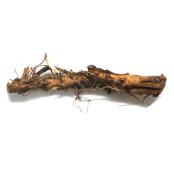Harvest and Drying Hop Rhizomes
Hop Rhizomes - Harvest & Drying
The harvest date will vary with variety and location but will become more evident as you gain experience as a grower. At maturity, the hops’ aroma is at its peak and can be measured by crushing the cone and smelling it. The yellow lupulin glands in the cone become much more evident and plump looking when magnified. The cone at maturity will develop a drier, papery feel along with a lightening in color. Squeeze the cones as they develop and you will notice they become more light and resilient rather than green and hard. Your harvest date will most likely be similar to the harvest date in the Pacific Northwest which begins the middle of August and continues until the middle of September. Early Harvest: Late Harvest: At harvest, it is easiest to cut the vine about 2-3 feet from the base of the mound and place the entire vine in an accessible place where the cones can be picked, rather than working off a ladder. Disease & Pest
Hallertauer, Tettnang, Fuggle
Cascade, Northern Brewer.
Drying can be done in a food dehydrator, custom made hop dryer, well vented oven, or air dried. If you use a dryer, good air flow is important and temperature should not exceed 140 degrees. Cooler temperatures take longer but a better quality hop is obtained. Under dry weather conditions, take a screen off your house and spread the hops around. Place the screen in the shade and support both ends off the ground. This is best achieved in a well vented area protected from strong wind. Fluff the cones daily so moist inner cones are brought to the outside of the pile. If the pile isn’t too thick they will dry in around 3 days. The hops are dry when the strigs, the inner stems of the cones, are brittle and break rather than bend. Pack hops into a heavy plastic bag or sealable container and keep frozen until used.
Insect pests are spider mites and aphids. Mites in hot, dry weather and aphids in cool weather. Spider mites can often be controlled by dusting with diatomaceous earth or commercial pesticide. Aphids should be sprayed with a soap spray or pesticide such as malithion.
 Hop Rhizomes & Clones |





